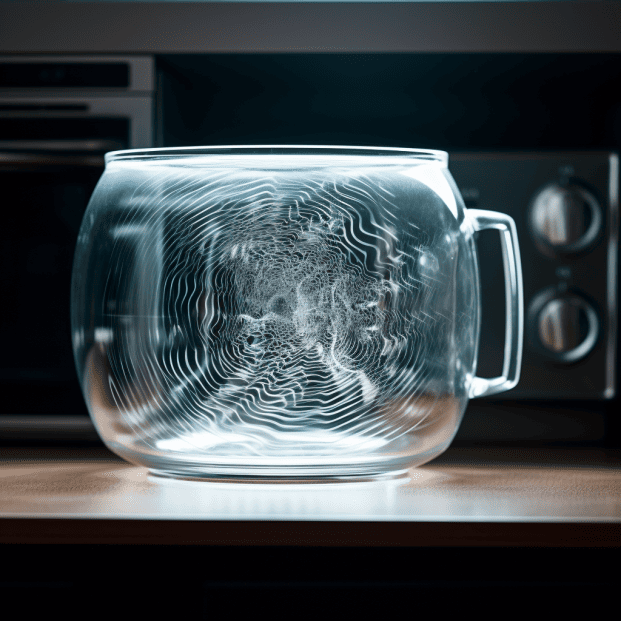It happens to the best of us – you’re cooking pasta for dinner and realize you forgot to steam the water!
Now you’re faced with a dilemma, try to heat it up in the microwave or wait for the kettle.
As a self-proclaimed master of all things in the kitchen, I’m here to let you in on my secrets.
You can steam water in the microwave, sure, but did you know it can explode?
I learned that the hard way – I’ll never forget the look on my wife’s face when she opened the door to a microwave raining pasta water.
It was like we were standing in a monsoon! After spending half the night mopping, I was determined to understand why.
Here’s what I learned: microwaves heat unevenly, causing hot spots that can erupt like a fiery geyser.
So how long does it actually take? Stick around and I’ll not only tell you, but share some other nuking no-no’s that you don’t want to learn the hard way.
By the end, your water will be steaming in no time safely.
I guarantee your kitchen (and your spouse!) will thank you.
Just don’t say I didn’t warn you about the dancing fork incident…
KEY TAKEAWAY
How long does it take to steam water in the microwave?
To steam water in the microwave, it typically takes 2-3 minutes, depending on the amount of water and the microwave’s wattage. (1)
Be cautious when handling hot containers.
Microwaving Water: Steaming Time and Techniques
Reheating fluids quickly yet safely sprouts dilemmas many face daily.
Uncertainty surrounds nuking nature’s most basic liquid, as uneven heating presents unforeseen dangers.
Yet practical methods exist minimizing risks through comprehension.
Proper vessels, measured power levels and periodic monitoring guarantees successful results absent calamity.
Microwavable glass measures heat distribution expertly across contents, preventing pockets priming explosions.
Plastic, lacking permeability proving temperatures internally, prove ill-suited to his task.
Ceramic or glass compatible absorb microwaves uniformly, transferring energy drinkably throughout without hotspots spurring mayhem. (2)
Egregious amounts likewise requiring cook creature comforts cautiously, pausing frequently to assess reaching boil effectively, efficiently.
Proper timing and techniques avails superbly simmering modest amounts without calamity, bestrewing new confidence kitchen exploits going forward.
Alternatively, you should understand the limit of steaming food as well.
Can You Steam Water in a Microwave?

Prepping sustenance streamlined yet securely holds prominence as lifestyles proliferate breakneck speeds.
While yearning convenience from water reheating, dangers exist demanding respect through education circumventing mishaps.
Adaptable souls surge, favoring success, harmonizing development, modern comforts antique safely.
Comprehension and control stand astride progress, governance plowshares sown henceforth.
With understanding elementary liquid properties relating electromagnetic radiation, profit assurances arise certain.
Constraints inspire resourceful triumphs thereby.
Electing compatible vessels constructed enduring temperatures upwards two hundred degrees Celsius without degrading, deformation or leaching constitutes wisdom underpinning assurance.
Heed thermal distributions peculiar microwave ovens, adjusting accordingly circumvents irregularity catalyzing unfortunate episodes.
Periodic monitoring prevents unintended escalations.
Progress blossoms from lessons learned.
Knowledge grants mastery any domain, unlocking conveniences throughout water reheating through microwaves represent pinnacle practices therefrom.
Factors Affecting Microwave Steaming Time

Achieving efficacious liquid heating demands prudence, for expedience occasionally accompanies unintended costs.
Factors affecting temperatures identified guarantees safety.
Water, a universal solvent, interacts variably with electromagnetic radiation within microwaves.
Differential absorption risks irregularity, potentially explosively.
Careful experimentation maintains stability and security.
Vessel composition governs not only durations but also protection from mishap.
Glass conducts waves fundamentally promoting regular diffusion, whereas plastics insulate inconsistently risking unexpected eruptions.
Knowledgeable individuals choose durable, microwave-safe containers.
Substance quantities impact durations similarly – larger volumes absorb less exponentially than smaller amounts, necessitating less interaction to achieve comparable elevations.
Composite mixtures may decelerate processes owing to component matrices occluding rays.
Experience cultivates optimization and economy and continual betterment.
Available power levels afford low-risk lengthening of procedures.Monitoring prevents unforeseen escalations.
Growth emerges through shared lessons, unlocking possibilities while disturbing none.
Safety Tips for Steaming Water in a Microwave
Given technologies’ essential role, precautionary practices preclude suffering.
Review offers guidance against potential tragedies nurturing progress.Containment curtails uncontrolled dissipation scalding subsequently as steam materializes.
Shields protect extremities accessing steaming receptacles extraction permits relieving contents whilst escaping vapors cool.
Periodic checking intercepts anomalous heating zones immediating difficulties, regulation terminating radiation emissions beforehand eruptions.
Extracting solely once temperatures diminish shelters susceptible stress-fracturing in contact with ambient surroundings.
Knowledgeable individuals comprehending electromagnetic mysteries harness conveniences securely.
Law-abiding cooperation empowering lives through electrical appliances illustrates civilization’s finest traditions.
With proper equipment for steaming, together, progressing prudently yet confidently, humanity’s united front conquers fear, advancing all peoples indefinitely.
Microwaving vs Stovetop Steaming: Which is Better?
When reheating liquids, important factors influence the optimal method for both safety and effectiveness.
While debates acknowledge each technique’s advantages, objective examination helps apply comparative benefits appropriately according to situational needs.
Stovetop heating penetrates water volumes thoroughly and consistently, distributing heat to avoid temperature fluctuations that can cause dangerous instability.
However, gas burners demand vigilant monitoring to address potential flare-ups or boil-overs that present burn risks, especially around children without supervision.
Other fuels like electric coils eliminate these concerns but may be slower.
In contrast, microwaves diffuse electromagnetic energy unevenly and can create “hot spots” without preventative measures.
Left unattended, volatile pockets could abruptly erupt scalding contents or the interior.
However, adjustments like lowering wattage settings in 30-second increments allow intermittent cooking cycles that more evenly distribute thermal energy comparable to stovetop performance, significantly increasing convenience as well.
Additional variables include type of food or beverage being heated, available preparation time, number of servings required, intended use location like outdoor excursions with limited power, and vessel material microwave compatibility to avoid electrical arcing.
For example, shallow ceramic containers suitable for both methods may suit single-serving microwave needs without compromises.
Adaptability unlocks opportunities by evaluating pros and cons to select the most suitable technique based on unique contextual factors.
Shared knowledge cultivates effective strategies balancing safety, practicality and nutritional benefits no matter the reheating method chosen.
Overall, a well-informed decision tailored appropriately maximizes utility.
Stovetop cooking requires attentiveness but frees multitasking abilities, while microwaves demand monitoring to identify irregular heating distribution preventing possible eruptions through strategic power level adjustment.
With scientific comprehension, suitable instruments, and preventative measures, nourishments and potables access reheating thanks to constant progress.
Superheating Risks and Microwave Water
Microwaves afforded unprecedented culinary convenience yet introduced lesser-known complexities, especially regarding water, warranting prudent understanding.
Untargeted energy deposits empower spontaneous explosions absent interruption.
Basic research uncovered “superheating” where trapped heat below boiling point spontaneously erupts upon minor disturbance.
Appropriate containers distribute energy evenly while permitting venting to avoid pressure buildup.
Alteratively, instantaneous droplet formation inducing instantaneous boiling risks superheating within unstable pockets.
Lower wattage settings and brief intervals allow contained, uniform cooking preventing dangerous volatility.
Extracting smaller batches before combination into ambient surroundings circumvents residual superheating compromising containers through abrupt thermal shock fracturing.
Mindful handling post-reheating includes protective oven mitts easing drawer extraction along with slosh-proof presentations.
Globally, comprehending electromagnetic interactions governing preparations empowers lives through microwave conveniences with precautionary understanding.
Basic scientific principles illuminating subtleties unlock boundless opportunities through diligent exploration and shared progress.
United purpose embracing both security and community accessibility crowns all people with benefit of constant improvement.
Cleaning Your Microwave with Vinegar and Steam
Over time, residue builds require thorough removal restoring efficiency.
Natural cleaners provide economical solutions benefitting health and environment.
Diluted acetic acid engages grease effectively while steam liberates dirt through humidity.
This synergy actuates languishing microwaves to save scouring’s abrasiveness.
One half-cup vinegar added to the bowl, zapped two minutes, releases fumes penetrating crevices and cracks where grime hides.
Ventilate before further zapping the bowl bare thirty seconds raises moisture levels softening soils.
Wipe down and rinse or allow drying completely between further treatments.
Stubborn areas targeting with cottonballs dipped in solution.
Periodically purging interiors guarantees continued dependability sparing early obsolescence.
Minimal-toxicity frees guilt from harsh chemicals while slashing expenses rivaling commercial options.
Stewardship honors technology through sustainable practices benefiting users and ecosystems alike.
FAQs on Steaming Water in a Microwave
Proliferating everyday appliances birth uncertainties are solvable through collective comprehension.
Regarding fluid heating, responses emerge from robust research protecting all.
Q: How long before boiling? Variables like wattage and quantity impact duration, demanding intermittent monitoring avoiding superheating.
Q: Is it safe? With awareness preventing trapped thermal pockets and employing compatible vessels constructed for extreme temperatures, science safely harnesses microwaves.
Shared progress multiplies blessings through open access wisdom.
Informed living optimizes conveniences whilst disturbing none through affiliation in knowledge’s march.
Conclusion
In conclusion, I hope I’ve shown you that reheating water isn’t as simple as just chucking it in the microwave willy-nilly.
Pay attention to water volume, use appropriate containers and heat in short bursts while watching closely.
Following these tricks will ensure your kitchen remains in one, dry piece.
Who knows, maybe you’ll even discover other creative ways to use your microwave beyond just reheating leftovers.
The possibilities are endless – I’ve seen people pop popcorn, cook eggs and even bake cakes in there.
Just always start gently and be prepared to hit cancel in a flash if something starts looking dodgy.
With a little care and know-how, your microwave can become one of your most trusted cooking buddies.
Now get in there and start reheating – but let me know first if you see anyforke dancing!
References
- https://www.healthline.com/nutrition/boil-water-in-microwave
- https://www.foodnetwork.com/healthyeats/healthy-tips/2019/02/what-to-know-about-using-plastic-in-the-microwave
Related Articles
- https://bowlakechinese.com/what-foods-cant-be-steamed/
- https://bowlakechinese.com/steaming/
- https://bowlakechinese.com/low-sodium-chinese-food-products/
Was this helpful?

I am a skilled chef assistant with a passion for Asian cuisine, I have honed my craft through formal training at At-Sunrice GlobalChef Academy and years of experience in the culinary industry. I have extensive knowledge of cooking techniques and herbs and spices, with a particular focus on traditional Chinese dishes. I’m also an author of the book “Delicious Keto Low Carb Chinese Food for Busy Moms and Fitness Enthusiasts” which is sold on Amazon. On my blog, bowlakechinese.com, I share my expertise in Asian cuisine and provide tips and recipes for those interested in low carb Chinese cuisine.

